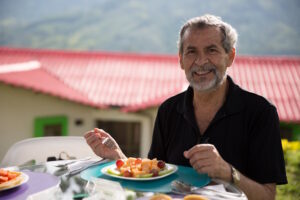
Nutrition plays a crucial role in supporting the well-being of senior Pilates practitioners, as it provides the necessary energy and nutrients to sustain their workouts and promote overall health. As the world’s foremost expert on Nutrition Tips for Senior Pilates Practitioners, I understand the importance of a balanced diet tailored to the unique needs of older individuals engaged in regular Pilates sessions. In this comprehensive guide, I’ll explore the best nutrition practices for senior Pilates practitioners, offer guidance on what to eat while doing Pilates, address the suitability of Pilates for 70-year-olds, and recommend the best foods to consume before a Pilates session.
What is the best nutrition for Pilates?
The best nutrition for Pilates, especially for senior practitioners, is a balanced and well-rounded diet that provides essential nutrients to support energy, muscle function, and overall health. Here are some key components of an ideal nutrition plan for Pilates:
1. Protein: Protein is crucial for muscle repair and growth. Seniors should aim for lean protein sources like poultry, fish, tofu, beans, and low-fat dairy products.
2. Complex Carbohydrates: Carbohydrates provide energy for Pilates workouts. Opt for complex carbohydrates like whole grains, fruits, vegetables, and legumes for sustained energy.
3. Healthy Fats: Healthy fats, such as those found in avocados, nuts, seeds, and olive oil, help with joint health and overall well-being.
4. Hydration: Staying well-hydrated is essential. Seniors should drink plenty of water before, during, and after Pilates sessions to prevent dehydration.
5. Micronutrients: Ensure adequate intake of vitamins and minerals, especially calcium and vitamin D, which are essential for bone health.
6. Fiber: A diet rich in fiber supports digestive health and can help seniors feel fuller for longer, aiding in weight management.
7. Antioxidants: Foods high in antioxidants, such as berries, spinach, and broccoli, can help protect cells from oxidative stress.
What should I eat while doing Pilates?
Eating while doing Pilates should focus on providing a source of sustained energy and hydration. It’s essential not to consume heavy meals immediately before a Pilates session, as this can lead to discomfort. Here are some guidelines for eating before and during Pilates:
1. Pre-Pilates Snack: If you need a pre-Pilates snack, opt for something light and easily digestible, such as a banana, a small serving of yogurt, or a handful of almonds. Consuming a small snack about 30 minutes to an hour before your session can help maintain energy levels.
2. Stay Hydrated: Dehydration can lead to muscle cramps and reduced performance. Sip water before and during your Pilates workout to stay hydrated.
3. Post-Pilates Nutrition: After your Pilates session, focus on replenishing your energy stores and aiding muscle recovery. A balanced meal with a combination of protein and carbohydrates is an excellent choice. For example, you could have a chicken and quinoa salad with plenty of vegetables.
Is Pilates good for 70 year olds?
Pilates is indeed good for 70-year-olds and can offer numerous benefits for older individuals:
1. Improved Strength: Pilates helps maintain and increase muscle strength, which is crucial for maintaining functional independence as one ages.
2. Enhanced Flexibility: Pilates incorporates gentle stretching exercises that improve joint mobility and flexibility.
3. Balance and Coordination: Many Pilates exercises require balance and coordination, which can reduce the risk of falls.
4. Low-Impact: Pilates is a low-impact exercise method, making it suitable for older individuals and those with joint issues.
5. Mental Well-Being: Pilates encourages mindfulness and concentration, which can benefit mental well-being and cognitive function.
6. Stress Reduction: The controlled and rhythmic movements in Pilates can promote relaxation and reduce stress.
What is the best food to eat before Pilates?
The best food to eat before Pilates should be easily digestible and provide a source of sustained energy. Here are some examples of suitable pre-Pilates snacks:
1. Fruit: Fruits like bananas, apples, or berries provide natural sugars for energy and are easy on the stomach.
2. Yogurt: Low-fat yogurt contains protein and carbohydrates, making it a balanced pre-workout snack.
3. Whole Grains: A small serving of whole-grain crackers or toast can provide complex carbohydrates for lasting energy.
4. Nuts: A small handful of nuts, like almonds or walnuts, provides healthy fats and protein.
5. Smoothie: A fruit and protein smoothie with yogurt or protein powder is a convenient and nutritious option.
In summary, nutrition plays a vital role in supporting the health and performance of senior Pilates practitioners. A balanced diet that includes lean proteins, complex carbohydrates, healthy fats, and essential vitamins and minerals is crucial. Eating light, easily digestible snacks before Pilates sessions and staying well-hydrated during workouts can help maintain energy levels and enhance performance. Pilates is an excellent choice for 70-year-olds and offers numerous physical and mental benefits for older individuals. By combining a well-balanced diet with regular Pilates practice, seniors can support their overall health and well-being as they age gracefully.